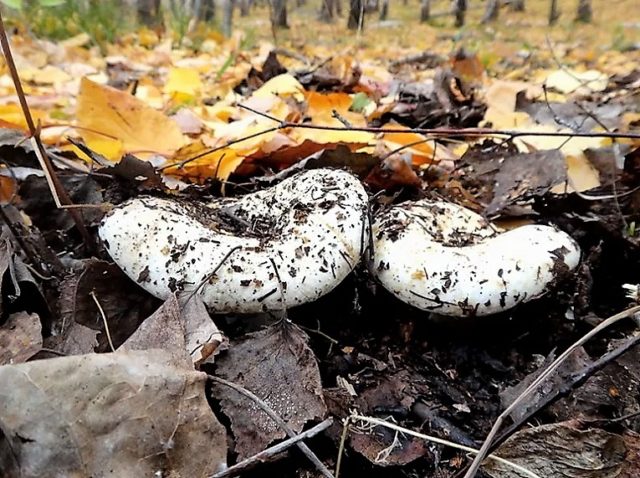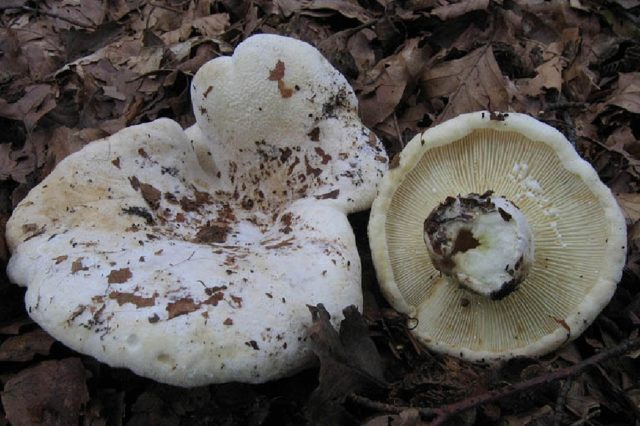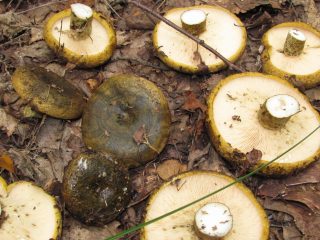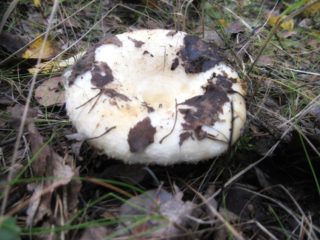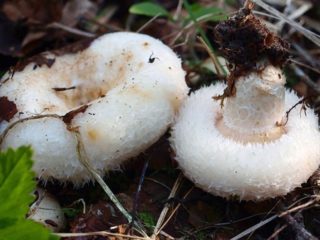Content
False milk mushroom is a common name for a number of mushrooms that in appearance resemble real milk mushrooms, or true milk mushrooms. Not all of them are dangerous when used, but it is necessary to be able to distinguish them in order to avoid making an unpleasant mistake.
Are there false milk mushrooms?
Among mushroom pickers, the word “false” is usually used to describe not one specific species, but a lot of varieties that in one way or another resemble a true milkweed. The category includes fruiting bodies that are externally similar, as well as species related to milk mushrooms with weaker nutritional qualities.

There are a huge number of varieties of false breasts
Thus, a false mushroom is one that can be confused with a real one based on one or another characteristic. It can be edible and inedible, tasteless, there are even poisonous milk mushrooms.To learn to understand the difference, you need to carefully study the photos and descriptions of the fruiting bodies.
How to recognize white milk mushroom
Of course, the edible and most delicious is the lamellar white milk mushroom, or true milkweed with a flattened cap up to 20 cm in diameter. It is yellowish or milky in color, with a small funnel-shaped depression. Its plates are also milky or yellowish-cream, the flesh is light and quickly turns yellow in the air.
Mushrooms that look like white milk mushrooms
In mixed and broad-leaved plantings, most often next to oaks, you can find doubles of the real milkweed. They are very similar in appearance, but real and false milk mushrooms are not so difficult to distinguish.
White poplar mushroom
This species grows in the same places as the real one. It has similar sizes of legs and caps, and the same yellowish or milky color. But you can distinguish it by one feature - the white poplar lacks a small fluffy fringe on the cap.
They can also be distinguished by their taste, although this is not obvious when harvested. White poplar is edible, but has a greater bitterness, which does not disappear after soaking.
White loader
Another false double also grows in mixed plantings, usually next to oak or pine trees. In appearance, color and aroma, it completely copies a real milkweed. The few differences are that there is no fringe on the edges of the cap, and the flesh on the break does not secrete bitter milky juice. The white load is edible.
Other mushrooms similar to milk mushrooms
In addition to the listed species, the true milkweed has many other false counterparts. Each of them deserves a more detailed consideration.
How to distinguish milk mushrooms from creaks
Skripun, or violin, is a mushroom from the genus Mlechnikov, often growing in groups in coniferous plantings and deciduous forests of Russia. Skripun has a wide funnel-shaped cap up to 20 cm with a wavy edge. The photo of the white false milk mushroom shows that the skin of the squeaky mushroom is dry with slight pubescence, whitish when young and slightly buffy when mature. The pulp is white and dense, with abundant milky juice, and the juice and pulp gradually turn yellow from contact with air.
A photo and description of the false white milk mushroom states that it is suitable for consumption and is used in salting and pickling, although it requires soaking before doing this. The species can be distinguished from each other mainly by shade - real adult milkweeds retain a whitish or yellowish color, but the squeaky one becomes dark.
From bitterling
Bitterweed, or bitterweed, grows mainly in the northern regions in moist forests, both deciduous and mixed. Its hat is medium in size, up to 8 cm, and at first has a flat-convex shape, and then becomes like a funnel with a small tubercle in the central part. The color of the cap is red-brown, dry and silky to the touch. The flesh of bitterling is whitish, eventually turning brownish without a distinct odor, and the milky juice is very acrid and bitter.

You can distinguish a white milk mushroom from a false one by color - the real type is much lighter. It is also permissible to use mustard for pickling, but first you need to soak it, boil it and only then preserve it.
From the milkman
The milky mushroom, or smooth mushroom, is a lamellar mushroom, very similar to the real one. The milkweed has a large flattened cap up to 15 cm in diameter, the color varies from brown to lilac or almost lilac.To the touch, the surface of the cap is smooth and slightly slimy, the flesh is yellowish, with white juice that turns green in the air.
You can distinguish a false milkweed from a true one by its color; it is much darker. In addition, in false milkweed, the milky juice at the break becomes greenish rather than yellow. The milkweed is considered edible; after processing, it is often used in pickling and canning.
From pepper
Pepper mushroom from the Russula family usually grows in deciduous forests in damp and shaded places. The false pepper mushroom, similar to the true one, has a slightly concave, flattened cap of cream color, lighter towards the edges. The flesh of the false pepper is light, with bitter juice.

You can distinguish the pepper variety from the real one mainly by its milky juice. In the real one it quickly becomes yellowish, but in the false pepper it takes on an olive or slightly bluish tint.
False pepper is sometimes used as food; it is salted after a long soaking. Otherwise it remains too bitter to consume.
From dry
Among the photos and descriptions of mushrooms similar to milk mushrooms, there is a dry false lacticaria; it has a large, wide cap of a concave shape and a whitish-cream color with brown circles. Its flesh is also creamy and dense, with a pungent taste. In dry weather, it often cracks on the cap, hence its name.
You can distinguish the dry false form from the real one by its smooth cap, devoid of slight pubescence. The mushroom is edible and is highly valued in cooking.
From the spruce row
Spruce row grows mainly next to pine trees, but it is not so often encountered in practice. Its cap is small, up to 10 cm, sticky to the touch and fibrous, semi-prostrate in shape.The color of the mushroom varies from light to dark gray with a slight purple tint, with the color being darker towards the center of the cap.
Although the spruce row is edible, it is still necessary to distinguish it from the real milkweed. The difference between the mushrooms lies in the color - the white true species is characterized by creamy rather than gray shades. In addition, the pulp of the row does not turn yellow when broken and emits a distinct floury aroma.
From the pig
The pig also belongs to the false doubles, since it has a flattened funnel-shaped cap up to 20 cm wide, with an edge tucked inward and a velvety surface. The pig's color is yellow-brown, sometimes slightly olive, with light brown flesh.
You can distinguish a false milk mushroom from a true one not only by the shade of color. The flesh of the double is brownish and darkens when cut, which makes it possible to distinguish it from the white flesh of the milk mushroom, which turns yellow in the air.
From the waves of whites
The white wave, or whitefish, has a small funnel-shaped cap, only 6 cm wide, fluffy and silky to the touch, with a hairy, curled edge. On the break, the wave is pinkish, with bitter and pungent juice.
You can distinguish the varieties from each other and identify the white milk mushroom precisely by its pulp; when broken, it does not have a pinkish tint. In addition, it is much larger in size, and the color is more yellowish-ocher than pink. You can eat white grass, but only after soaking.
From toadstool
You can even confuse the true milkweed with the poisonous pale grebe.The deadly mushroom has a flattened, wide cap with plates underneath, white or milky-greenish and milky-yellowish in color.
The main thing that helps to distinguish a toadstool is the presence of an ovoid seal at the top of the leg. Also, the cap of the toadstool is not covered with light hairs, like that of the edible white milkweed. Eating toadstool is strictly prohibited; it causes fatal poisoning.
From camphor
Camphor milkweed, which is a false twin, grows on damp soils, mainly in coniferous forests. His hat is small, up to 6 cm, standard funnel-shaped with wavy edges. The texture of the cap is glossy, the color is reddish-brown, the flesh is brick-brown in color with an unpleasant camphor odor.
Although both species secrete white milky juice, it is very easy to distinguish the camphor type from a photo of the false milk mushroom. The false mushroom is darker, and its flesh is also dark. False camphor is not edible, it is bitter, and processing does not eliminate this defect.
Inedible and poisonous mushrooms similar to milk mushrooms
Among the photos and descriptions of false milk mushrooms and doubles, one can identify species that are completely unsuitable for food consumption.
- Death cap - the species is deadly poisonous and is absolutely not suitable for food.
- Camphor milkweed - this species, examined in detail, tastes too bitter. It is not poisonous, but inedible.
- Golden yellow milkweed - a species with a bright golden color can be distinguished from the true variety by color. It tastes very bitter, so it is classified as inedible.
Conclusion
False mushrooms have many forms and names; this is the name given to more than a dozen different mushrooms that resemble the true species in shape, color and pulp. Not all doppelgängers are dangerous to humans, but some of them are poisonous, so it is imperative to be able to distinguish them.


